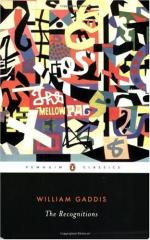|
This section contains 476 words (approx. 2 pages at 400 words per page) |

|
The Recognitions Summary & Study Guide Description
The Recognitions Summary & Study Guide includes comprehensive information and analysis to help you understand the book. This study guide contains the following sections:
This detailed literature summary also contains Topics for Discussion on The Recognitions by William Gaddis.
In this sprawling and largely-forgotten novel of 1952, author William Gaddis takes as his theme the fake, the flaky, the fraudulent, and the phony in religion, the art world, academia and every nook and cranny he can put under his satirical microscope. In its scope, the novel is as broad as Balzac, as beat as Kerouac, and as rhapsodic as Thomas Wolfe. The characters, an always-changing stream of individual egos pitted against an absurd world, are by turns funny, desperate, deluded, and myopic. Gaddis bites off a huge chunk of the world but does a masterful job of breaking it down for the reader so that in its particulars, the human comedy unfolds in all of its compulsive reactions to fear in a post-war nuclear age. By carefully excavating all the manifestations of fear on human behavior, Gaddis succeeds in showing the reader how corrosive the need to adopt a mask or persona is to spiritual integrity.
The story unfolds largely through the lives of expatriate Americans living in Europe. These include artists, writers, musicians, forgers, and Catholic priests, all of whom are afflicted with various levels of delusional thinking that they identify as their own search for truth and their own unique identity. Their universal problem is the ego, which does not yield them the satisfaction or serenity they seek. Some seek release from this frustration in drug addiction and a bohemian lifestyle while others find their release through efforts to control others. Ultimately they are all living in a hell of their own creation, serving life sentences locked in the prison of their own egos.
The art counterfeiter and the forger convince themselves they are great artists because of the skill with which they produce fakes. At least one artist finds in heroin addiction an empty substitute for the love and recognition she is denied. A priest uses the internecine layers of authority and protocol in the Catholic church to avoid facing his own mortality and powerlessness. Other minor characters try control, dominance, or physical escape to avoid facing the duplicity of their lives.
In many ways, this 1950s novel is a bell weather of social changes during the Cold War that would come to fruition in the 1960s. The underlying angst of the characters is clearly identifiable as fear. This is the kind of fear that drove school children under their desks in simulated nuclear attacks and that produced alternative lifestyles as a way of saying no to "the establishment" with its foreign wars, intercontinental ballistic missiles, and lockstep corporate conformity. These are characters spawned in the Beat Generation that would later become the spiritual antecedents of the Dropout Generation. In its search for authenticity, this generation must face its own delusions and contradictions while it also faces those of the world, as William Gaddis makes plain in this work.
Read more from the Study Guide
|
This section contains 476 words (approx. 2 pages at 400 words per page) |

|



